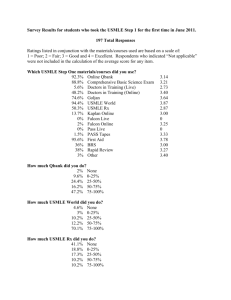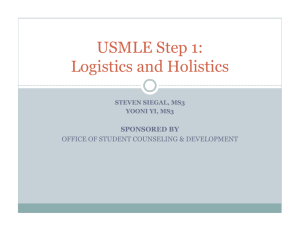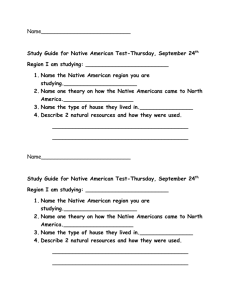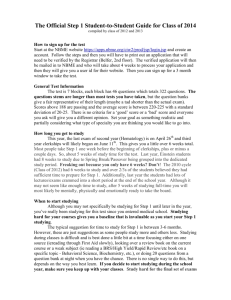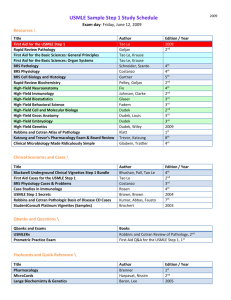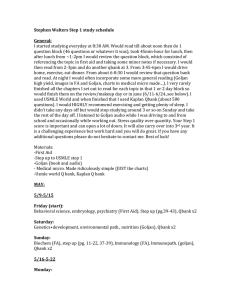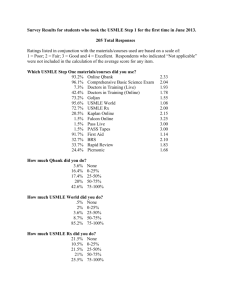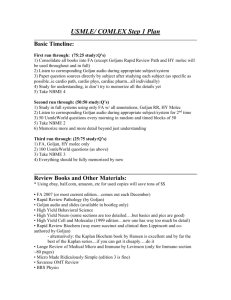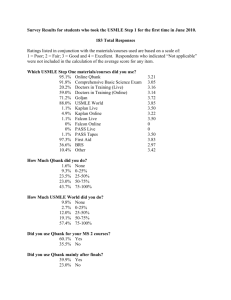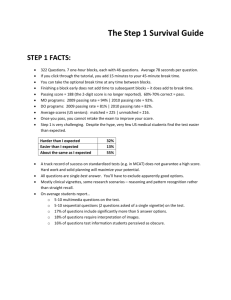Summer Resource Guide
advertisement
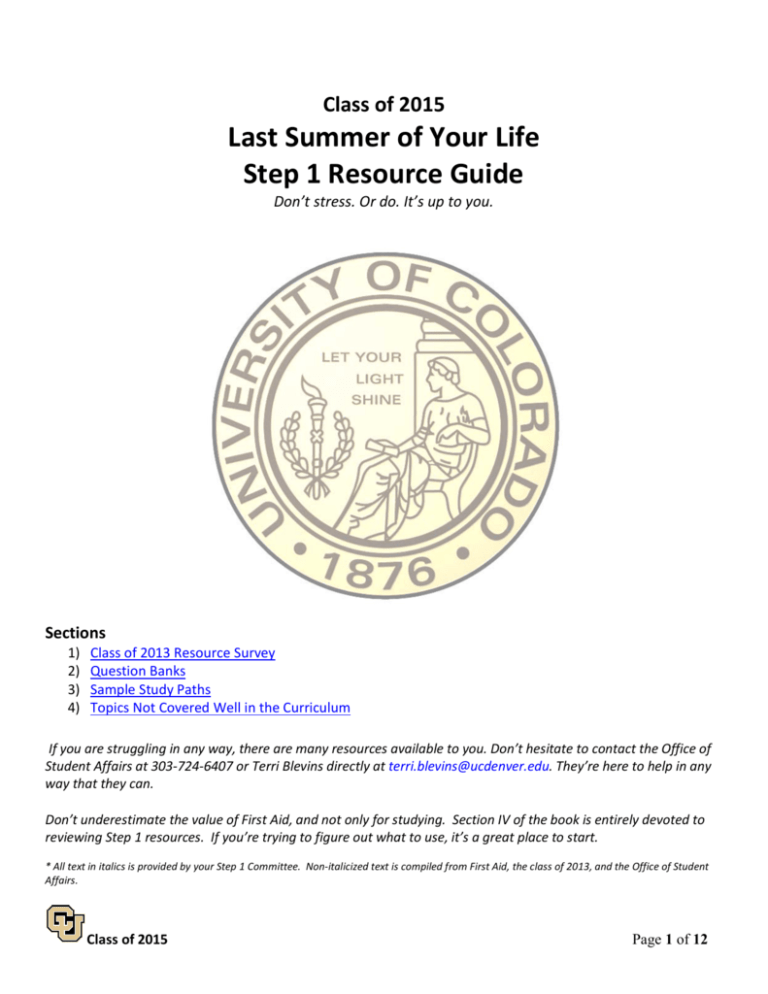
Class of 2015 Last Summer of Your Life Step 1 Resource Guide Don’t stress. Or do. It’s up to you. Sections 1) 2) 3) 4) Class of 2013 Resource Survey Question Banks Sample Study Paths Topics Not Covered Well in the Curriculum If you are struggling in any way, there are many resources available to you. Don’t hesitate to contact the Office of Student Affairs at 303-724-6407 or Terri Blevins directly at terri.blevins@ucdenver.edu. They’re here to help in any way that they can. Don’t underestimate the value of First Aid, and not only for studying. Section IV of the book is entirely devoted to reviewing Step 1 resources. If you’re trying to figure out what to use, it’s a great place to start. * All text in italics is provided by your Step 1 Committee. Non-italicized text is compiled from First Aid, the class of 2013, and the Office of Student Affairs. Class of 2015 Page 1 of 12 Class of 2013 Resource Survey Resource Use How helpful? Did not use Not at all 0 68.8 67.7 0 0 9.7 90.3 64.7 45.5 11.8 9.1 17.6 9.1 5.9 36.4 Pathology a. BRS Pathology b. Rapid Review: Pathology (Goljan) c. Goljan Audio Files d. Robbins Pathologic Basis of Disease 46.2 8.6 9.1 40.9 15.8 2.2 1.4 23.9 19.3 14.0 3.6 40.3 38.6 32.4 28.3 23.9 26.3 51.5 66.7 11.9 Pharmacology a. Lippincott’s Illustrated Reviews: Pharmacology b. Dr. French’s Pharmacology Handouts c. BRS Pharmacology d. Pharmacology Flash Cards – Brenner e. Pharm Cards – Johanssen and Sabatine (Lippincott) 62.9 25.3 68.3 57.5 41.4 39.3 8.0 73.7 25.0 12.2 21.4 26.0 5.3 30.0 10.8 25.0 50.0 30.0 50.0 14.3 16.0 21.1 15.0 27.0 Physiology a. BRS Physiology – Costanzo b. Physiology – Costanzo (Elsevier) 18.8 66.7 5.3 65.0 6.1 33.3 25.0 55.3 10.0 Anatomy and Embryology a. Langman’s Embryology b. High Yield Embryology c. High Yield Anatomy and/or Neuroanatomy 45.2 68.3 62.9 18.8 55.0 37.9 29.7 20.0 13.8 34.4 20.0 34.5 17.2 5.0 13.8 Behavioral Science a. High Yield Behavioral Science b. BRS Behavioral Science 67.7 64.0 60.0 5.0 25.0 10.0 42.3 23.1 15.4 19.2 Biochemistry a. Lippincott’s Illustrated Review: Biochemistry 37.1 11.8 11.8 43.4 32.9 Cell Biology and Histology a. Wheaters Functional Histology b. High-Yield Cell and Molecular Biology 37.1 39.8 11.8 38.5 11.8 7.7 43.4 23.1 32.9 30.8 Microbiology and Immunology a. Clinical Microbiology Made Ridiculously Simple b. Microcards – Lippincott 53.2 59.9 23.3 34.9 39.5 2.3 91.7 8.3 (reported in %) Comprehensive a. First Aid b. Step Up c. Kaplan Series Class of 2015 Very little Somewhat A great deal Page 2 of 12 How many total practice questions did you complete from the following question banks? (response %) Did Less 500 1,001 1,501 – More Not than 1,000 1,500 2,000 than Use 500 Q’s 2,000 76.9 6.8 5.1 2.6 4.3 4.3 a. Kaplan Qbank (2,248 questions) b. USMLErx (2,621 questions) c. USMLE World (2,034 questions) Class of 2015 30.1 12.6 17.5 16.1 11.2 12.6 3.8 1.9 7.1 24.4 16.7 46.2 Page 3 of 12 Question Banks Here is a list of some of the most used question banks that are available. The grades and descriptions are pulled directly from First Aid 2012 and prices are current as of 5/22/12. As shown by Dr. Guiton, students who go through more questions tend to do better on Step 1, so you may want to begin going through questions this summer. Some people recommend beginning with Kaplan or USMLERx and then moving to USMLEWorld as you get closer to the test, but others choose to go through a single question bank more than once. A+ USMLEWorld Qbank www.usmleworld.com Subscription Cost 3 Months $185 6 Months $299 12 Months $399 USMLEWorld also offers group rates, but requires the entire group to purchase the same subscription. There will likely be a classorganized group in January, but feel free to organize your own group. 2000 questions An excellent bank of well-constructed questions that closely mirror those found on Step 1. Questions demand multistep reasoning and are often more difficult than those on the actual exam. Offers excellent, detailed explanations with figures and tables. Features a number of test customization and analysis options. Unfortunately, the program does not allow other application windows to be open for reference. Users can see cumulative results both over time and compared to other test takers. AKaplan Qbank www.kaplanmedical.com Subscription Cost 1 Month $99 12 Months $199 2400 questions A high-quality question bank that covers most content found on Step 1, but sometimes emphasizes recall of overly specific details rather than integrative problem-solving skills. Test content and performance feedback can be organized by both organ system and discipline. Includes detailed explanations of all answer choices with references to First Aid. Users can see cumulative results both over time and compared to other test takers. AUSMLERx Qmax www.usmlerx.com Subscription Cost 1 Month $99 3 Months $149 12 Months $199 3000 questions A well-priced question bank that offers Step I-style questions accompanied by thorough explanations. Some obscure material is omitted, making it more straightforward than other question banks. Each explanation includes high-yield facts and references from First Aid. However, the proportion of questions covering a given subject area does not always reflect the actual exam's relative emphasis. Question stems occasionally rely on "buzzwords." Most useful to help memorize First Aid facts. Provides detailed performance analyses. B+ USMLE Consult www.usmleconsult.com Subscription Cost 30 Days $75 60 Days $115 90 Days $135 Class of 2015 2500 questions A solid question bank that can be divided according to discipline and subject area. Questions are more straightforward than those on actual exam. Offers concise explanations with links to Student Consult and First Consult content. Users can see cumulative results both over time and compared to other test takers. Student Consult also offers a Robbins Pathology Test Bank ($35 for I month, $49 for 3 months) featuring 500 USMLE-style questions as well as the Scorrelator ($35), a 3-hour, ISO-question mock exam that predicts your USMLE Step I score. Limited student feedback on Student Consult products. Page 4 of 12 Sample Study Paths These are sample study strategies that were assembled by the class of 2013. We have not included the specific schedules for study, but will be updating them at the beginning of the fall semester. We’ve included the main descriptions to give you at least some idea of what next year might look like and how you may wish to prepare this summer. One of the best ways to reduce anxiety for this test is to figure out what you are going to do to prepare, when you are going to do it and how. This is why we compiled a list of sample study paths from the classes of 2011 and 2012. We don’t think it makes sense to create a solitary “CU Plan” because we know that everyone learns differently. It’s important to think about your learning style to figure out if you are a text-reader, a Goljanlistener, a question-taker or a mix. This is why we worked hard to find four of the most diverse (and proven to be successful) study paths so that you don’t have to waste time fumbling around in the dark. Use these examples as a guide and feel free to edit/combine/tailor them to your individual needs. In the end, studying for STEP1 is an individual thing- you only get out of it what you put in. This is a well-written test that all of you can do very well on if you spend time on your own to truly understand the material. Class of 2015 Page 5 of 12 #1 The Start Early! Plan “Big Time Boards” This is a study plan designed for the student who wants to start early, spread out the workload across a long period of time and cover ABSOLUTELY EVERYTHING before boards time. If you are a person who likes to work at a steady pace and be thorough, this is the plan for you. It takes a lot of endurance and dedication, but if taken seriously this plan can get you an incredible score. Start in DEMS: 1. Buy Goljan Pathology 2. Buy a question bank. I recommend first buying Kaplan/USMLERx and switching to World when you start your studies at the end of ID/LC. I found World to best represent the content and style of the real test. 3. At the end of neuro, write out a week by week schedule from then until the end of ID/LC. Organize it by chapters in Goljan or the question divisions in Qbank (divided up by subject/organ system). The subjects can break up in as many weeks as you find appropriate. Some will require more time than others. Most will take a single week. I found the best way to do this is to figure out how many weeks you have until the dedicated study period, figure out how many pages in first aid are devoted to each subject and then divide up the weeks based on how many pages are devoted to each subject. For example, biochemistry was a thick chapter in first aid so I spent 3 weeks working on it. (During DEMS to kill 2 birds with one stone) 4. Optional: Pick a buddy to keep you honest. If you have a study buddy you work well with, plan a day to meet each week where you will teach one another the topic you have studied. Even if they get nothing out of you teaching you will get something out of having to teach it. This will motivate you to prepare for the session and help to expose the areas you do not know as well. 5. Throughout the week you will focus solely on that subject. Read the section in First Aid first, then read the corresponding BRS Phys chapter then listen to the corresponding Goljan audio while taking notes in the path book. I tried to successively work through these books for each week(s) I had assigned to each subject. Do short 10 question subject specific tests on Qbank each night and supplement your studies as you like with other review books. At the end of each week do a full length and cumulative Qbank test (46 questions) that includes only the topics you have already covered. Every time you do a qbank question, read the ENTIRE answer list of wrong and right answers and take notes in First Aid. Mark all the pages in FA where you took notes and then go over these pages the next day prior to studying that day. This way you will utilize repetition and really learn from the qbanks. 6. There is plenty of time. It is okay to skip a week or take longer than expected on difficult subjects. Just don't get in the habit of it. Also, reassess you progress periodically and figure out how many chapters you have left and speed up or slow down your schedule to finish all the topics before the dedicated study period. 7. Take advantage of winter break. This is a good time to focus on the high yield subjects like CVPR. 8. Don't let the stress of classes cause you to bail on the plan. In the grand scheme, your Step 1 score is worth the sacrifice. 9. Expect to devote a good 5-6 hrs a week to your boards studies. Just 1 hr per night will get you FAR!! Class of 2015 Page 6 of 12 At the end of ID/LC: 1. This is the most important time to stay focused. 2. Set a goal. Decide on a score that will make you happy and decide on a second score that you do not think you deserve or are legitimately capable of achieving. It helps. 3. Switch to USMLE World Qbank- it’s almost exactly like the exam. 4. Pick one day every week to be your simulated exam day. On these days take four or so straight tests then read and review the answers. I recommend studying for 2 ½ – 3 weeks before taking the test. This way you will stay intense and focused the whole time and have a good two weeks to go out and play before starting rotations. Trust me, you will not need the entire 4-5 weeks of dedicated study period to be prepared if you have been working since DEMS. 5. The real exam is broken down into 7 segments of 48q tests. They are an hour a piece with an extra hour break to be use at your discretion. I recommend treating every morning similar to the test day. 6. Wake up and start a full 48q test at 8am every morning. 7. Take a good 2-3 hours to go over all the answers to that test and takes notes in FA 8. This will take you to about noon. Take a break. Have lunch, exercise, watch an episode of Curb Your Enthusiasm... 9. After an hour break, take a second 48 question test and then go over it for the next couple hours. 10. If you do 100 questions per day for 3 weeks you will have done a 2000 question qbank and you will be so ridiculously prepared for STEP1, it will feel great! Class of 2015 Page 7 of 12 Recommendations for studying: • Be excited and focused on every question. I found highlighting the pertinent details with my cursor as I read to be helpful. • Do not get bummed out by bad tests. Somebody suggested I view my bad tests as ones that taught me the most about topics I knew the least. I found this to be extremely helpful. Tests that you ace make you feel good but you are simply answering things you already knew. • Treat every test like it is the real thing. Sit at a desk and don't take breaks in between questions. Read the answers and explanations to every question. Do not skip over questions you get correct or explanations to incorrect answer options. • You can only study so many hours in a day before it stops helping. Don't overdo it. Just stay focused and stick to your schedule. Then go out and play. • On the day before the exam do whatever makes you relaxed. If that is exercising, exercise. If it is studying, study. • Qbank is key. It not only focuses your studies and teaches you how to recognize testable content while you study, but it teaches you how to read and anticipate Step 1 questions. Pros and Cons to this method: Pros: • You will cover every topic before beginning your post LC/ID studies. This prevents a lot of anxiety. Many of my peers that started late panicked during the boards studying period because practice tests were not going well. They got disorganized and second-guessed everything they did. • It is a comfortable pace that you will unlikely burn out on. • Every time you sit down to study from November to April you will know what you are studying. You will not bounce around from topic to topic doing unfocused and unproductive studying. • It is high yield. By sticking to Goljan, BRS Phys and the Qbank you will not waste your time with things that are not easily or commonly tested. • You will be done in time to for the EnduroChallenge at A-Basin. Cons: • It takes time away from regular course work. Passing a class will not be an issue and honoring is definitely more than possible if you are devoted and stick to it. • It requires organization. While this is true, if you make a plan at the beginning and stick to it in general you will be fine. Just make sure to make board studying a priority. Class of 2015 Page 8 of 12 #2 Spring Method I decided to start studying a little early b/c although I did well in all my classes I have no memory! So I wanted more time to review/relearn the material. I essentially used the spring semester to use my First Aid book as a workbook (pages separated and bound in a 3-ring binder). I added everything I didn’t know to this book using the resources outlined below. I especially used the answers from USMLEWorld Qbank to annotate and increase my knowledge. Although I dedicated a substantial amount of time to studying for boards during the ID/LC blocks I was still able to honor. So if you must honor these blocks b/c you have honored all the other blocks then know it is still possible. If you have not consistently honored then it may be best to do your best on boards and forget about trying to honor ID and/or LC (which can be a challenge!). Christmas break: I studied about 4 days. I wanted 5 but only got in 4. This was very helpful b/c it takes a while to get into the swing of things and gain and understanding of just how long it takes to get through a chapter in First Aid. I did not dedicate more time because I really needed a vacation and I also knew that I was going to study a lot beginning Jan 2nd!!! So I wanted to have a nice relaxing vacation before I went back to work and hit it hard. Spring: I used BRS Phys A LOT. I also used Goljan Path and the famed audio recordings. I wrote down everything I didn’t know in First Aid, or I took extra notes that I added to my First Aid binder. I wrote out all the equations from First Aid on a separate piece of paper. I added many equations and little tricks to this sheet from things I found in Qbank, etc. I also included the statistics stuff here, and equations taught to us in class during LC. Dedicated Study Period: I worked from 8 am to 11 pm every day, taking an average of 3hours off total per day to eat and see my family. I used only THREE resources during this period: My heavily annotated and now text-book like copy of First Aid, Qbank and Wikipedia! I skimmed Goljan Path a few times and listened to about 4-5 hours (total) of Goljan while driving (kinda dangerous actually!) after I finished certain chapters that were complicated for me (CV, Heme-onc etc.). I did NOT have time to do anything else. Each morning I would do 48 Qbank random/all inclusive questions in TIMED mode and then review the answers writing everything into my First Aid. In the afternoon I would do another 48 questions on the material I covered that day using the TUTOR mode. I read the ENTIRE answer, understanding why I was right/wrong and what else I could learn. Generally in the beginning it took me 3-4 hours to complete 48 questions. But as I learned more and started to improve I could do a 48 question section in 2.5 hours. This may seem like a long time but I think this was VERY valuable! Because I used the questions for all their worth, I did not have time to use any other resources. But I didn’t have to! I had already ready BRS Physiology and a fair amount of Goljan Path and had put what I needed into my First Aid book. Final Point – You cannot know everything, and for the real exam you will feel like you know nothing. What got me though was having an understanding of how to approach questions with general knowledge and eliminate wrong answers. For example – If you get a heme-onc question and they show you a blood smear think: what cancers would looking at a blood smear be helpful? What cancers cannot be diagnosed this way? Are there Auer Rods, are their Roulade RBS’s etc. Think what are the common findings of the answer’s given in the answer choice etc. This kind of reasoning is best achieved by doing tons of questions and understanding how to approach them and why some answers are right/wrong/better. Class of 2015 Page 9 of 12 ID – I used MicroCards and Clinical Microbiology Made Ridiculously Simple. I annotated the MicroCards with information for class notes as well as from CMMRS. I LOVED my MicroCards so much I would sleep with them! I reviewed these cards for the boards and added things to First Aid. I also used PharmCards – The summary cards are very helpful…but aside from that I am unsure of their utility. I studied micro hard! It really does pay off. In the end, due to a family emergency I had to take the boards early. I therefore stared my dedicated study time 2 weeks before classes ended. I did NOT study for ID or LC CLASS at all. I only studied for the boards. I organized my schedule so that I would complete these chapters just before the finals. I spent an extra day on Micro, read JR’s learning objectives (took me 6 hours and this is ALL the studying I did for class) and got a 94 on the ID final exam! I tell you this only to stress how relevant the ID material is to the boards! LC – Print out color images of the pictures from Dr. Erickson’s lectures. Add these to your First Aid binder! They are very helpful. ANNOTATE the images with the information she gives in her notes. This class can be a bit tricky. Read the behavioral sciences chapter of First Aid before the final exam. This information is very, very relevant. My two schedules Follow: I tried to mix up subjects I hated with those I loved. For the dedicated study period I but Biochem at the end b/c there is a lot of memorization of pathways etc. I also reviewed psych drugs, behavior science and the psych chapter again at the end of my study time. CBSSA: 3 during spring, 2 during dedicated study period. More if not passing. X-mas break: Review CV, P, R Chapter’s first aid: Dedicated 8 hours, 4-5 days of break. Annotate First Aid Chapters with info from: -BRS Physiology, Constazo; Goljan Pathology; Goljan Audio; etc! January-March: Each week during spring dedicate 3-5hrs/day15-20 hrs/week. Each week during spring meet 1x/wk for 2-3hrs to review/teach with Study Buddies (2-3) **Each night before bed (1hr) Review FA chapter from the day before and notes taken in it! This is HUGE! **Review pharm and micro cards each day for every other day. *Study Pharm with each pertinent section. Review pharm each day adding drugs to be reviewed after each section. Review all. * Tab FA pages for review (Pages that are all memorization). Review on review days. Class of 2015 Page 10 of 12 #3 Studying in Groups Some people found it useful to study in groups. Although this schedule isn’t terribly detailed, it is meant to serve as a reminder that if you find you study well by teaching, groups may be fabulous for you. There were 4 people in our group and we tried to set it up so that we went through First Aid 2010 once over the 10 weeks that was LC/ID. We would meet every Friday afternoon for about 5 hrs and go through the chapters together. Another idea would be to assign each member of the group a particular subject that they would then present to the group. It all depends on what you want to do and what your group dynamic is like. This can be a nice add-on to one of the other study plans and a great motivator. Wk 1- Biochemistry Wk 2 – Immunology, Pathology Wk 3 – Cardiology, Renal Wk 4 – Psych, Respiratory Wk 5 – Behavioral Sciences, GI Wk 6 – Neurology Wk 7 - Neurology Wk 8 – Pharmacology, Endocrinology Wk 9 – Embryology, Reproductive, Part Micro Wk 10 – End Microbiology Class of 2015 Page 11 of 12 Topics Not Covered Well in the Curriculum Our curriculum prepares students well for Step 1, however, like any school there are certain topics that are either not taught well or not taught at all, but are tested on Step 1. When students come across these topics in their study, it is often very anxiety provoking and there is concern that there are tons of other topics that are also not covered in the curriculum. To fill those gaps, we have compiled responses from students from previous years and have listed those topics below. Set aside some extra time to learn these topics well. a. Human Body b. Molecules to Medicine c. Blood and Lymph d. Disease and Defense e. CVPR f. Nervous System g. DEMS h. Infectious Diseases i. Life Cycles What topics/concepts could be taught better? – (Please be specific) Clinical correlation with specific injuries 2nd messenger systems, toxins/antidotes, nutrition, biostats (2X2 tables) lymphoma and leukemias, bone cancers (osteosarcomas, etc.), immunomodulator drugs connective tissue disorders, collagen disorders, antibiotics, chemotherapeutic agents CV drugs – antiarrhythmic drugs, nephritis/nephritic syndromes antipsychotic drugs, personality disorders, neuroanatomy mitochondrial dz, glycogen storage dz, lysosomal storage dz, inborn errors of metabolism, urea cycle, vitamin deficiency/toxicities Viruses, TORCHES, MMR developmental milestones Class of 2015 Page 12 of 12
